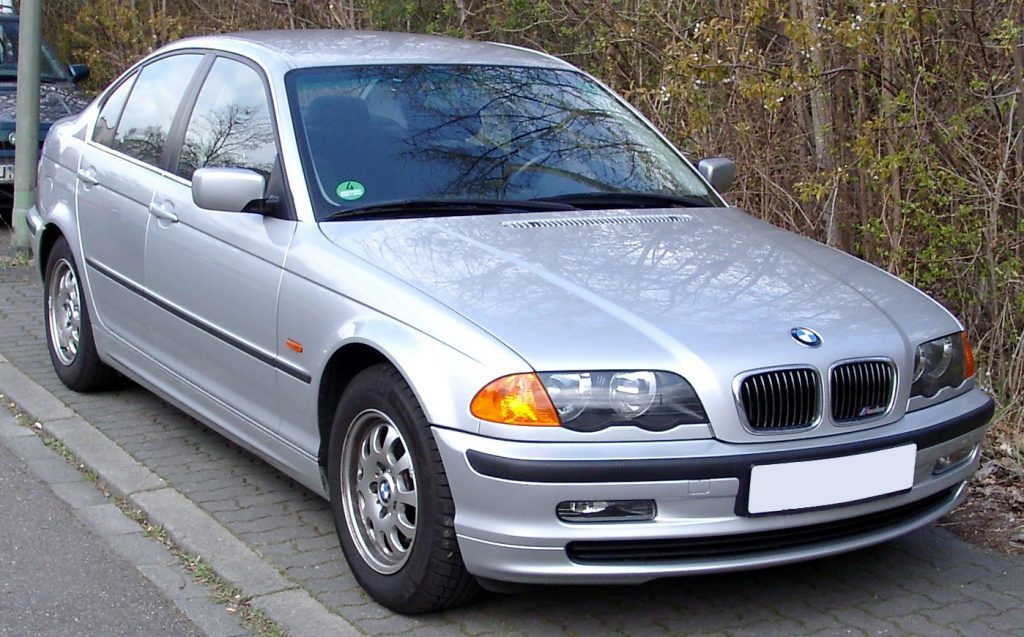
History
The E46 3 series was introduced in 1998 as successor to the E36 model. It can be considered an evolutionary upgrade of the E36, as the initial engines are revised versions of the engines offered in the E36 (M43, M52), and the interior (instrument cluster, front seats, steering wheel, etc.) are similar or even identical. It has also been called the last true BMW 3 series, with its relatively straightforward pre-Bangle looks and dashboard oriented towards the driver, a typical BMW feature that was dropped with the successor model (E90). It is also more compact than the E90. To me, the E46 marks the high point of BMW design, with all three ranges (including the E39 5-series and the E38 7-series) having both a face of their own and a family look, too – whereas the current 3, 3, and 5 can be hard to distinguish, especially from the rear.
In typical BMW manner, the car was originally introduced as sedan. The other body variants followed, eventually leading to the same variety as offered with the E36: sedan, touring (station wagon), coupé, convertible, and compact. The latter was set apart from the rest of the range by different lights, which might have contributed to the rather poor sales of the E46 compact model. The other body styles sold well. In Germany, the E46 was at times the second most popular car, outsold only by the VW Golf.
The E46 received a facelift (LCI – life cycle impulse in BMW speak) about halfway through its production (sedan & touring in 2001, coupé & convertible in early 2003), with the most important change being new lights and the availability of new engines (N42 four-cylinder with Valvetronic, M54 six-cylinder). The successor E90 was phased in starting in 2005.
Performance
The E46 was available with a wide range of engines, from a 1.6l four-cylinder to a 3.0l six-cylinder. The engines employed were initially improved versions of the engines used in the E36, but with the same power figures – from 105 HP for the 316i to 193 HP for the 328i. The new engines introduced in 2001 brought a new top engine, the 231 HP 3.0l engine. Dry weight is between 1350kg and 1600kg for the closed gasoline versions. This makes the cars with the 3.0l engine quite quick, with 0-100kph times of 6.5s and a maximum speed of 250kph. But even the lower-powered cars (if you stay away from the entry-level engine, or the automatic transmission) feel quite quick and responsive, thanks to the good weight distribution and rear-wheel drive.
Pros
Prices are bottoming out, so even a 330i is an affordable car with performance that was attributed to true sports cars only a decade earlier. Cars with factory suspension are comfortable, too, and all modern amenities like air conditioning, cruise control, and even navigation are available. Add the classic BMW looks and driving pleasure, and I’m sure that especially the top-end 330i models will become desirable and more valuable at some point.
Cons
Early six-cylinder models (until the facelift in 2001) have a tendency to tear our their rear axles. Stay away from these. The problem was reduced but not completely eliminated after that. The engines are quite complex – VANOS, and Valvetronic in the N42 four-cylinders starting in 2001 – which means that proper maintenance and good oil (preferably 0W40, changed regularly, especially when driving mostly short distances) is a must to keep them running happily. The crank case ventilation is an often-mentioned issue. The six-cylinders have a reputation of being more reliable than the N42 four-cylinders, but a VANOS revision may still be in order. Rough driving will have worn out the suspension. Many cars have also been modified by the owners, which will impact value negatively in the future.
My pick
All-original late-model 330i coupé with six-speed manual transmission and M package, blue with chrome window trim. The option list, in typical BMW fashion, was long – I’ve seen bare-bones 330s that only had the sunroof ticked on the option list, so make sure that the car you go for has the essential stuff like sports seats and the sports or M steering wheel. Stay away from the SMG gearbox,
If you’re on a budget, consider the 318ti compact. Less desirable means cheaper, and the four-cylinders are cheaper to run, too.